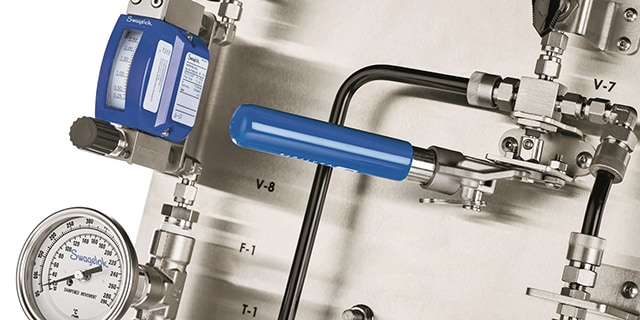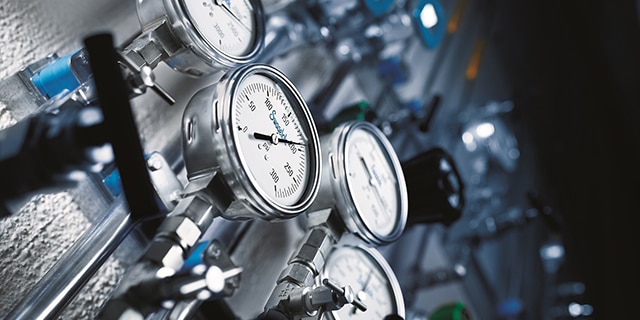Avoiding Classic Liquid and Gas Sampling System Mistakes

Avoiding Classic Liquid and Gas Sampling System Mistakes
Sampling system design is a delicate process; any small misstep can lead to unreliable system operation. Many errors that occur today also plagued designers in the past. Now is the time to learn how to avoid errors related to liquid and gas sampling systems.
Getting Better Gas Samples
Gases behave differently with fluctuations in pressure and temperature – both of which are likely to occur in a sampling system. These fluctuations can result in condensation or time delay—affecting analyzer results. To avoid these issues, try to reduce a gas sample’s pressure as soon as possible, by as much as possible. Doing so will reduce the sample’s temperature, which helps minimize condensation potential as the gas flows through the sampling system. Reducing the pressure also minimizes heating needs down the line. You can drop gas sample pressure at regulators and restrictors, such as needle valves, orifices or capillary tubes. Condensation will be more likely on the high-pressure side of these components.
When designing a gas sampling system, never:
- Transport a Gas at its Dew Point Temperature: A gas at its dew point temperature is saturated and likely to condense at any moment. Reduce the pressure or heat the line. You may have the most success heating the line; the pressure drop might not prevent further condensation if the gas cools somewhere down the line.
- Assume that Insulation Will Keep a Gas Line Warm: Insulation can help—however, any pressure drops within the system will reduce the gas temperature. Eventually, the gas may reach its dew point temperature and condense. Therefore, use heat tracing to ensure uniform heating along the line as needed.
- Have an Unheated Line Upstream of a Pressure Drop if you Heat the Downstream Side: Remember, the gas sample temperature will decrease at the point of the pressure drop. The resulting temperature differential will be even higher in this scenario, which means a greater potential for condensation.
- Fail to Heat a Regulator Dropping More than 20 bar: When a gas encounters a drastic pressure loss, it also experiences a drastic temperature loss – so much so that the regulator may ice over. This is due to the Joule-Thomson effect. By heating the regulator, and likely the adjacent tubing and other components, you can mitigate this effect.
- Run Unheated Tubes in an Air-Conditioned Shelter When the Outside Lines are Heat Traced: The rapid temperature drop – from warm to cool – will result in unwanted condensation potential, as well as a reduction in pressure. Continue the heat tracing on the line inside the shelter.
Getting Better Liquid Samples
Where gas samples require a significant reduction in pressure, liquid samples, on the other hand, necessitate a pressure increase for as long as possible. This is because liquids drop pressure when traveling through long tubes or flow restrictors. Higher pressure on the frontend will help move fluid further through the system at a greater pressure, potentially eliminating any need for a downstream pump and helping reduce time delay.
When designing a liquid sampling system, never:
- Transport a Liquid at its Bubble Point Temperature: The bubble point temperature is the initial boiling point of the liquid and can be much lower than expected, particularly when the liquid contains dissolved gas. Try to keep the pressure up as high as possible all the way through the analyzer.
- Drop Liquid Pressure at the Tap: Dropping liquid pressure right at the point of the tap may lead to a significant time delay or the need to install pumps downstream. Remember, you want to maintain enough pressure all the way from the tap through any intermediate components to the analyzer.
- Install a Needle Valve before an Analyzer or Flowmeter: The pressure drop caused by a needle valve or other restrictive device is likely to release vapor bubbles into the liquid flow, which can interfere with analyzer results. You want to keep the pressure high and the temperature low (but not below the pour point of the liquid) to avoid bubbling.
- Install a Needle Valve before a Vaporizer: Time delay is common in many parts of liquid sampling systems, but the inlet line of a vaporizer is the most frequent culprit. It’s hard to get a five-minute analyzer response when a vaporizer is involved. Installing a needle valve before the vaporizer will slow the process further.
Setting Yourself Up for Success
Sampling system design is a delicate art—every system is different from the next. The above advice will help you improve your sampling success, making life easier on the next system designer who uses your design.
Looking to further hone your sampling system design skills? Sign up for hands-on sampling system training to help you and your team design effective, accurate systems. Contact your local Swagelok sales & service center for more information. You can also visit the Analytical Instrumentation section of Swagelok Reference Point to learn more sampling system tips and tricks from Swagelok instructors and field engineers.
Related Articles

Common Challenges with Process Sampling Systems
Sampling system experts and industry veterans, Tony Waters and Phil Harris, share some common challenges they have encountered with process analyzer sampling systems over the years. Learn how to resolve recurring issues within your sampling system.

10 Tips to Improve Sampling Systems
Managing an analytical instrumentation operation is no small feat. Receiving consistent results can be a struggle for even the most seasoned engineers. Luckily, there are several simple tips your team can use to improve your sampling system.

5 Common Process Analyzer System Revelations over 50 Years of Training
Sampling systems can be one of the most challenging systems within your plant to both design and operate. Industry veteran and industrial training instructor, Tony Waters, shares his trainees’ top revelations over the past 50 years.

